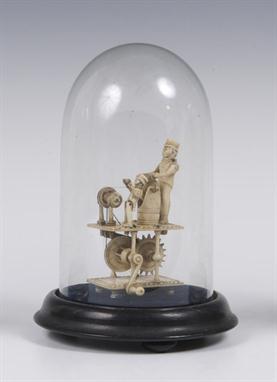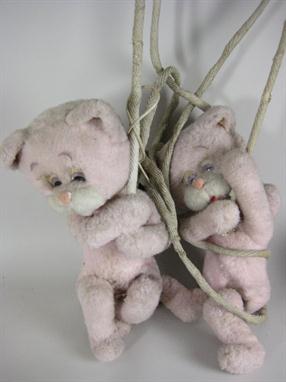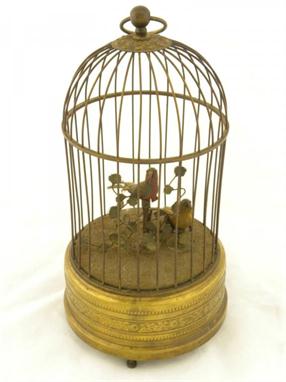We found 4753 price guide item(s) matching your search
There are 4753 lots that match your search criteria. Subscribe now to get instant access to the full price guide service.
Click here to subscribe- List
- Grid
-
4753 item(s)/page
A French automaton singing bird table clock, circa 1860, central tree and stump surmounted by three birds, central bird on ground head faced down, accompanied by birdsong, driven by movement within base, enamel clock dial with Roman numerals, striking on a bell, Louis Japy movement, glass dome, height 56 cm.
An interesting early 19th century hallmarked silver pair cased open face pocket watch, the polychrome enamel dial decorated with a landscape depicting three horses pulling a cart and a windmill automaton, the gilt fusee movement with verge escapement and finely pierced and engraved cock piece signed JN Stone, Aylesbury, hallmarked for London 1836 (hairline and losses to dial) (Illustrated).
A FINE 19TH CENTURY CONTINENTAL SILVER AND ENAMEL ‘SINGING BIRD’ AUTOMATON MUSICAL BOX most probably of Swiss origin, having a central domed bird cage enclosing the mechanical feathered bird and pieced gilt metal grill, the rectangular top engine turned and enamelled in blue, the facia with painted cherub vignette and gilt metal mounts, raised on four scrolling gilt metal legs, marked 935 to underside along with other marks, sold with remains of original case. 12cm(h) x 11cm(w) x 7.5cm(d).
Fine Napoleonic French Prisoner Of War automaton having two polychrome decorated straw work platforms, the upper with two seated figures, a dancing blackamore harlequin and partner and a figure with spinning wheel, the lower platform with two soldiers and two ladies flanking an elaborate network of cogs, the handle attached to a pierced and carved foliate panel, 18cm high
A Roullet et Descamps Musical Automaton of a Performing Doll, French, circa 1900, as a Spanish dancing girl "Carmen", the Simon & Halbig head with open mouth and teeth, blue glass flirty eyes, brunette wig, standing on a red velvet lined dais, her right hand upheld and swinging a tambourine towards her tilting head, raising her left foot (and her right foot moving left and right), the square base containing a key wound comb and cylinder mechanism, in traditional Spanish clothing with embroidered detail, 51cm high
A novelty Art Deco electric automaton mantel clock by Vitascope, with brown patterned bakelite case, and rocking three masted clipper ship in glazed aperture above chrome circular dial, with electric movement, impressed 06723 and with UK, US, Swiss, Belgium and French patent applied for marks
A fine and rare eight-day longcase clock by Thomas Pyke of Bridgwater, Somerset, circa 1790-1830, with an automaton scene of a couple hitting a ball backwards and forwards to each other, the unusual square brass dial has illustrations of the four seasons engraved into the corners, engraved within a decorative ribbon motif in the centre signed THOMAS PYKE, BRIDGWATER, the twelve inch brass break-arch dial with Roman hour and Arabic minute numerals, a seconds ring below twelve o`clock, a half-moon date aperture, and contemporary blue steel hands, within the arch is a wonderfully painted scene showing a gentleman and lady hitting a ball to each other, the ball passes to and fro, as if counting the seconds and quite unusually when the ball meets each racket, the racket moves to hit the ball back again, the mahogany case has a swan neck pediment supported by fluted columns which are in turn surmounted by brass Corinthian capitals, height 217cm., 85 1/2in., width 52cm., 20 1/2in., depth 28cm., 11in. It is believed that the scene portrays the game of Field Tennis, a distant forerunner of Lawn Tennis. It appears that the term "Field Tennis" was first penned by William Hickey in 1767. In his diaries, edited by Peter Quennell in 1978 as The Memoirs of William Hickey he described how "he (a boisterous, hard living attorney) and some friends played this game in London: In the summer we had another club, which met at the Red House in Battersea Fields, nearly opposite Ranelagh, a retired and pretty spot ... This club consisted of some very respectable persons, amongst them were Mr. Powell, of the Pay Office; Mr. Jupp, the East India Company`s architect; Mr. Whitehead, a gentleman of independent fortune; King, the celebrated actor; Major Sturt of the Engineers; and others. The game we played was an invention of our own and called field tennis, which afforded noble exercise …The situation of the house, which was close upon the edge of the river, and no public carriage road near it on the land side, rendered it as private as if it had been exclusively our own … Our regular meetings were two days in each week, when we assembled at one o`clock, at two sat down to dinner ... At four our sport commenced, continuing until dark; during the exercise we refreshed ourselves with draughts of cool tankard, and other pleasant beverage. The field, which was of sixteen acres in extent, was kept in as high order, and smooth as a bowling green … Our club consisted of twenty and was always well attended; any member who absented himself, no matter from what cause, on a dub day forfeited half a crown, which was put through a hole made in the lid of a box, kept under lock and key, and opened only once a year, when the amount of forfeits was laid out in an extra dinner at the Red House, generally about 20th. December ... Besides our regular days, some of the members met every evening during the summer months to have a little field tennis." The game was obviously very popular for some time, and did not, it seems, contain itself as a regional pastime. A passage in the Sporting Magazine (Vol.2 P.371, Sept. 29th 1793) shows its vitality as an open air game: "Field Tennis threatens ere long to bowl out cricket. The former game is now patronized by Sir Peter Burrel; the latter has for some time back been given up by Sir Horace Mann." For a longer, more in depth investigation into these clocks, please see the article: `Automated Field Tennis` by Bob Everitt. (The Tennis Collector, No.32, April 1998, p.8).
A GOOD GEORGE III MAHOGANY EIGHT DAY LONG CASE CLOCK BY MASON OF LONDON, the brass automaton movement with domed top dial and automaton ship, with silvered chapter ring, subsidiary seconds dial and date aperture, set within a well figured case with column sides, cross-banded door and supported on a platform base. 7ft 10ins high.
A silver quarter repeating Jacqumart watch with erotic automaton, signed on the gilt cuvette Forestier, Grenadier au 59me, white enamel chapter ring, decorated silver bells and figures, a slide in the case band revealing a couple on a couch, the case plain with push pendant, 60mm dia, circa 1820.
John Maltby (British, b.1936) Peter Grimes and Albert Herring , an Automaton wall piece, circa 1992 Painted wood and mixed media, painted signature Provenance: Private Collection. Exhibited: Rufford Craft Centre, 1992" In good condition Height 20.2cm, Width 30.8cm, Depth 6cm View on auctionatrium.com
An early 19th Century North Country English mahogany and cross-banded cased long case clock, the arched hood with turned, ringed and rope-twist decorated pilasters, the main body similarly decorated with triple arched door, the eight day movement with painted arched dial, the spandrels decorated with figures emblematic of the four seasons surmounted by the sun and moon phase automaton, the chapter ring with Roman numerals enclosing a subsidiary seconds dial and gate dial and maker`s name "W M O... STER"
-
4753 item(s)/page




















































